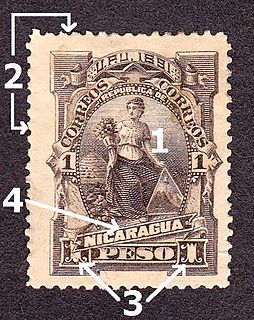
A postage stamp is a small piece of paper issued by a post office, postal administration, or other authorized vendors to customers who pay postage, who then affix the stamp to the face or address-side of any item of mail—an envelope or other postal cover —that they wish to send. The item is then processed by the postal system, where a postmark or cancellation mark—in modern usage indicating date and point of origin of mailing—is applied to the stamp and its left and right sides to prevent its reuse. The item is then delivered to its addressee.

Stamp collecting is the collecting of postage stamps and related objects. It is an area of philately, which is the study or study and collection of stamps. It has been one of the world's most popular hobbies since the late nineteenth century with the rapid growth of the postal service, as a never-ending stream of new stamps was produced by countries that sought to advertise their distinctiveness through their stamps.

A postmark is a postal marking made on an envelope, parcel, postcard or the like, indicating the place, date and time that the item was delivered into the care of a postal service, or sometimes indicating where and when received or in transit. Modern postmarks are often applied simultaneously with the cancellation or killer that marks postage stamps as having been used. Sometimes a postmark alone is used to cancel stamps, and the two terms are often used interchangeably. Postmarks may be applied by handstamp or machine, using methods such as rollers or inkjets, while digital postmarks are a recent innovation.
A first day of issue cover or first day cover (FDC) is a postage stamp on a cover, postal card or stamped envelope franked on the first day the issue is authorized for use within the country or territory of the stamp-issuing authority. Sometimes the issue is made from a temporary or permanent foreign or overseas office. Covers that are postmarked at sea or their next port of call will carry a Paquebot postmark. There will usually be a first day of issue postmark, frequently a pictorial cancellation, indicating the city and date where the item was first issued, and "first day of issue" is often used to refer to this postmark. Depending on the policy of the nation issuing the stamp, official first day postmarks may sometimes be applied to covers weeks or months after the date indicated.

A cancellation is a postal marking applied on a postage stamp or postal stationery to deface the stamp and to prevent its reuse. Cancellations come in a huge variety of designs, shapes, sizes, and colors. Modern cancellations commonly include the date and post office location where the stamps were mailed, in addition to lines or bars designed to cover the stamp itself. The term "postmark" refers specifically to the part that contains the date and posting location, but the term is often used interchangeably with "cancellation" as it may serve that purpose. The portion of a cancellation that is designed to deface the stamp and does not contain writing is also called the "obliteration" or killer. Some stamps are issued pre-cancelled with a printed or stamped cancellation and do not need to have a cancellation added. Cancellations can affect the value of stamps to collectors, positively or negatively. Cancellations of some countries have been extensively studied by philatelists, and many stamp collectors and postal history collectors collect cancellations in addition to the stamps themselves.

The Penny Black was the world's first adhesive postage stamp used in a public postal system. It was first issued in the United Kingdom, on 1 May 1840, but was not valid for use until 6 May. The stamp features a profile of Queen Victoria.
The Private Express Statutes (PES) are a group of United States federal civil and criminal laws placing various restrictions on the carriage and delivery of letters by all organizations other than the United States Postal Service.
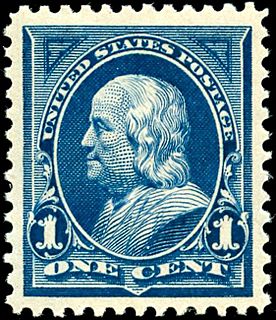
Postal service in the United States began with the delivery of stampless letters whose cost was borne by the receiving person, later encompassed pre-paid letters carried by private mail carriers and provisional post offices, and culminated in a system of universal prepayment that required all letters to bear nationally issued adhesive postage stamps.

Indian postal systems for efficient military and governmental communications had developed long before the arrival of Europeans. When the Portuguese, Dutch, French, Danish and British conquered the Marathas who had already defeated the Mughals, their postal systems existed alongside those of many somewhat independent states. The British East India Company gradually annexed the other powers on the sub-continent and brought into existence a British administrative system over most of modern-day India, with a need to establish and maintain both official and commercial mail systems.

In philately, the term cover pertains to the outside of an envelope or package with an address, typically with postage stamps that have been cancelled and is a term generally used among stamp and postal history collectors. The term does not include the contents of the letter or package, although they may add interest to the item if still present. Cover collecting plays an important role in postal history as many covers bear stamps, postmarks and other markings along with names and addresses all of which help to place a cover at a given time and place in history.

A philatelic cover is an envelope prepared with a stamp(s) and address and sent through the mail delivery system for the purpose of creating a collectible item. Stamp collectors began to send mail to each other and to themselves early on, and philatelic mail is known from the late 19th century onward. While some collectors specialize in philatelic covers, especially first day covers and cacheted covers, others regard them as contrived objects that are not reflective of real-world usage, and often will pay a higher price for a cover that represents genuine commercial use. However, mail sent by stamp collectors is no less a genuine article of postage than is mail sent with no concern of seeing the mailed item again. Philatelic covers include mail from first airmail flight and first day of stamp issues ceremonies. Over the years there have been numerous Expositions where special postmarks are made and where a post office is set up where mail can be sent from on the given date of the Expo'. Like any other genuine item of mail these covers include postage stamps and postmarks of the time period and were processed and delivered by an official postal system. Often a philatelic cover will have more historical significance than randomly mailed covers as philatelic covers are also often mailed from the location on the date of an important or noteworthy event, like an inauguration or a space launch.
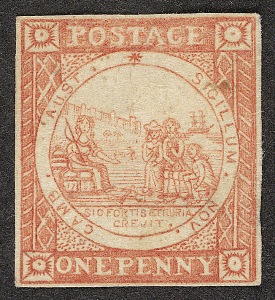
This is a survey of the postage stamps and postal history of New South Wales, a former British colony now part of Australia.

Stamp albums are books used to house a collection of postage stamps.

A revenue stamp, tax stamp, duty stamp or fiscal stamp is a (usually) adhesive label used to collect taxes or fees on documents, tobacco, alcoholic drinks, drugs and medicines, playing cards, hunting licenses, firearm registration, and many other things. Typically, businesses purchase the stamps from the government, and attach them to taxed items as part of putting the items on sale, or in the case of documents, as part of filling out the form.
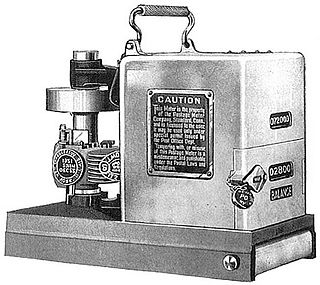
A postage meter or franking machine is a mechanical device used to create and apply physical evidence of postage to mailed items. Postage meters are regulated by a country's postal authority. A postage meter imprints an amount of postage, functioning as a postage stamp, a cancellation and a dated postmark all in one. The meter stamp serves as proof of payment and eliminates the need for adhesive stamps.
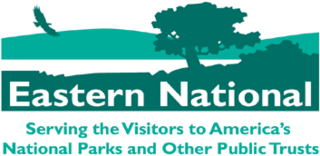
Eastern National is a nonprofit Cooperating Association based in Fort Washington, Pennsylvania, that partners with the National Park Service in the United States. It was created by charter in 1948 to "provide quality educational products and services to the visitors to America's national parks and other public trusts." As of June 16, 2009, Eastern National has donated over $100 million to their partners.

Stockbooks are storage books used by stamp collectors for storage of postage stamps placed in pockets, on pages, for easy viewing. Other philatelic items, such as plate blocks, miniature sheets, covers, lettersheets, etc., can be stored in stockbooks.

Definitive postage stamps of Ireland are the regular series of definitive postage stamps issued by the Irish Free State between 1922 and 1937 and by Republic of Ireland since 1937. Nine distinctly different series of designs have been released; additionally the watermark was changed for two issues and the currency was changed on three occasions while the designs remained the same.

The National Park Travelers Club is a non-profit 501(c)7 social club organization. Its mission is to provide networking and recognition opportunities for visitors to America's National Park System. This Club acts to support and expand appreciation of the U.S. National Park System.

Revenue stamps of the United Kingdom refer to the various revenue or fiscal stamps, whether adhesive, directly embossed or otherwise, which were issued by and used in the Kingdom of England, the Kingdom of Great Britain, the United Kingdom of Great Britain and Ireland and the United Kingdom of Great Britain and Northern Ireland, from the late 17th century to the present day.




















